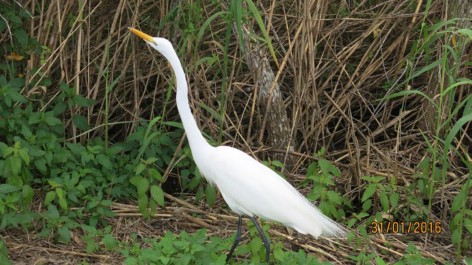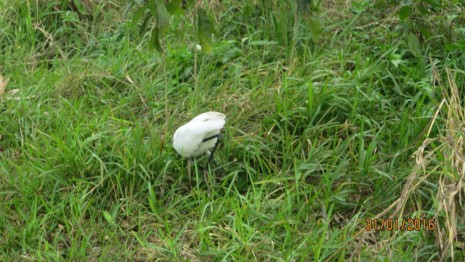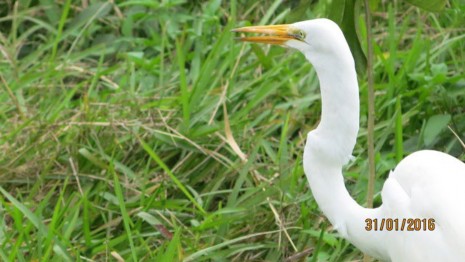William E. Davis, Jr.

Figure 1. Great Egret foraging for terrestrial invertebrates along Anhinga Trail. All photographs by the author.
On January 31, 2016, I visited Anhinga Trail in Everglades National Park, Florida. The water level was the highest I had ever seen there and few herons were present. At about 11:00 am, I noticed a Great Egret foraging in dry habitat near the path at the interface between short grass and tall grass and shrubbery. It was alternately using Walking Slowly and Stand and Wait foraging behaviors. I spent 20 minutes watching the Great Egret and I counted at least four attacks in which insects—or other terrestrial prey—were taken from the low shrubs and grass. In one case, the orange wing of what I am sure had been a grasshopper was displayed during ingestion. The foraging behavior included the bird slowly walking by the low shrubs with its neck held forward and with the bill slightly raised above the horizontal (Figure 1). It swayed its neck back and forth while keeping the head and bill stationary, but sometimes moved its head side to side as well. The side-to-side movement is thought make use of the parallax phenomenon to provide the bird with a precise estimate of the strike distance to prey (Kushlan 1978, Hancock and Kushlan 1984). The egret was visually foraging and, when an insect was located, it struck with the usual lightning bill thrust.
About 3:00 pm, I located a Great Egret foraging in exactly the same way at Eco Pond at Flamingo. This pond is some 33 miles away from Anhinga Trail and thus this egret was almost certainly a different bird. I followed this egret for about 10 minutes and observed the same stealthy walk with head and neck held forward and bill slightly raised, as well as the neck and sometimes side-to-side head movement I had seen with the first bird. I photographed it striking at an insect and holding prey in its bill (Figures 2, 3). On the drive back from Flamingo to the park entrance, I counted four more Great Egrets that, in brief observations, also appeared to be foraging for terrestrial invertebrates in a similar manner. I saw few Great Egrets out in the wet habitats; more than half the birds I saw during the day were foraging in terrestrial habitat.
 |
|
Figure 2. Great Egret strikes at a terrestrial invertebrate at Eco Pond.
Great Egrets mostly forage in aquatic habitats and their primary prey consists of fish. In one study, fish constituted 95% of prey and 98% of prey weight. Invertebrate prey included primarily aquatic invertebrates but also terrestrial insects including dragonflies, damselflies, and grasshoppers (McCrimmon et al. 2001). Another study added dung beetles and earthworms (Schlorff 1978). Clearly, terrestrial invertebrates usually contribute but a tiny fraction of the Great Egret diet. If so, why did I encounter so many Great Egrets foraging in terrestrial habitats even though they were surrounded by a sea of water and sawgrass, their traditional foraging environment? The answer probably lies in the weather events that dominated South and Central Florida during January 2016. A brief Internet survey indicated that El Nino-influenced storms produced nine inches of rain in January, about five times the historical average, in what is usually the heart of the Florida dry season. It was the wettest January since 1932 (South Florida Water Management District News Release, February 1, 2016), resulting in high water levels across South and Central Florida including Everglades National Park. Conditions were so bad that Lake Okeechobee threatened to flood the area. Hence, the federal authorities lowered the lake level with a resulting increase in water levels in parts of Everglades National Park.

Figure 3. Great Egret with a prey item in its bill at Eco Pond.
Studies have indicated that Great Egret numbers tend to decrease when water depths exceed 8–16 inches and that their distribution in the Everglades is tightly linked to water depth (McCrimmon et al. 2001). Thus it seems likely that high water levels forced the Great Egrets out of their usual feeding sites and caused them to shift to foraging in terrestrial habitats. I suspect that the high water levels may also have led to a wide dispersal of small fish and that the resulting low density of prey fish may also have influenced the Egrets’ shift to an insect diet.
Literature cited
- Hancock, J., and J. A. Kushlan. 1984. The herons handbook. New York: Harper & Row.
- Kushlan, J. A. 1978. Feeding ecology of wading birds. in Wading Birds (A. Sprunt IV, J. C. Ogden, and S. Winckler, Eds.), p. 249–297. New York: National Audubon Society, Research Report No 7.
- McCrimmon, D. A., Jr., J. C. Ogden, and G. T. Bancroft. 2001. Great Egret (Ardea alba) in The Birds of North America, No. 570 (A. Poole and F. Gill, Eds.). Philadelphia: The Academy of Natural Sciences; Washington D.C.: The American Ornithologists’ Union.
- Schlorff, R. W. 1978. Predatory ecology of the Great Egret at Humboldt Bay, California. in Wading Birds (A. Sprunt, IV, J. C. Ogden, and S. Winkler, eds.) p. 347–353. New York: National Audubon Society, Research Report, No. 7.